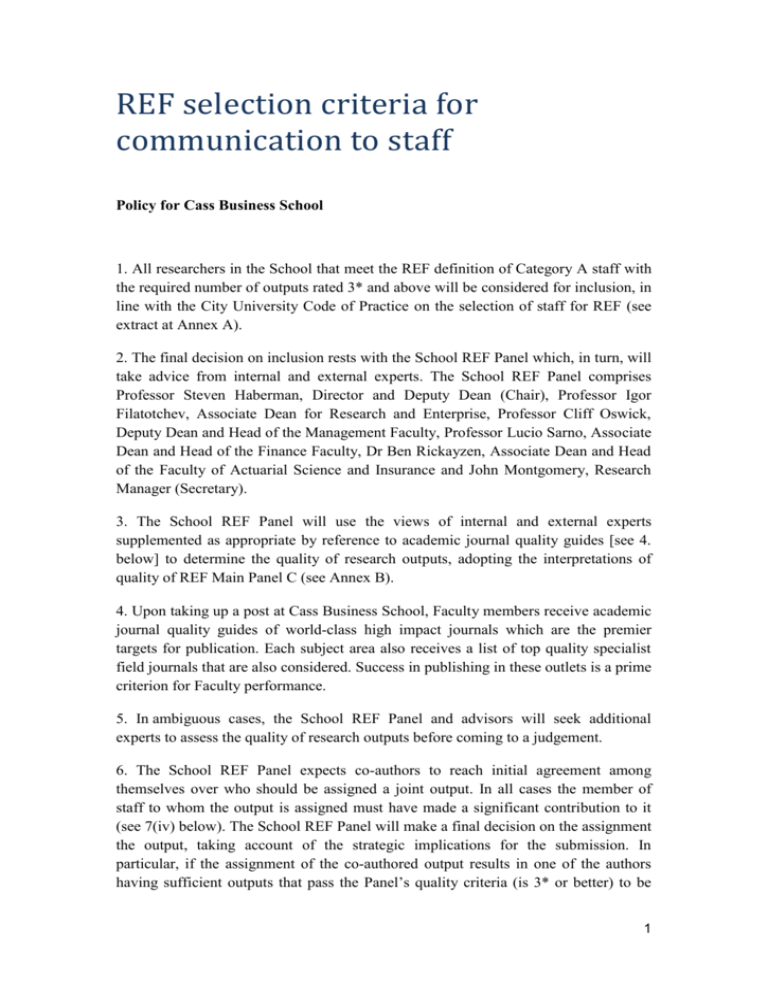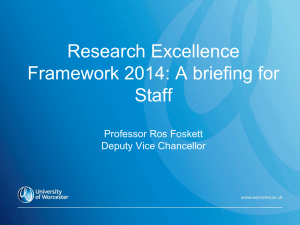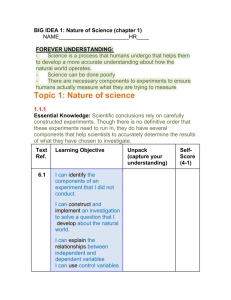REF selection criteria for communication to staff Policy for Cass
advertisement

REF selection criteria for communication to staff Policy for Cass Business School 1. All researchers in the School that meet the REF definition of Category A staff with the required number of outputs rated 3* and above will be considered for inclusion, in line with the City University Code of Practice on the selection of staff for REF (see extract at Annex A). 2. The final decision on inclusion rests with the School REF Panel which, in turn, will take advice from internal and external experts. The School REF Panel comprises Professor Steven Haberman, Director and Deputy Dean (Chair), Professor Igor Filatotchev, Associate Dean for Research and Enterprise, Professor Cliff Oswick, Deputy Dean and Head of the Management Faculty, Professor Lucio Sarno, Associate Dean and Head of the Finance Faculty, Dr Ben Rickayzen, Associate Dean and Head of the Faculty of Actuarial Science and Insurance and John Montgomery, Research Manager (Secretary). 3. The School REF Panel will use the views of internal and external experts supplemented as appropriate by reference to academic journal quality guides [see 4. below] to determine the quality of research outputs, adopting the interpretations of quality of REF Main Panel C (see Annex B). 4. Upon taking up a post at Cass Business School, Faculty members receive academic journal quality guides of world-class high impact journals which are the premier targets for publication. Each subject area also receives a list of top quality specialist field journals that are also considered. Success in publishing in these outlets is a prime criterion for Faculty performance. 5. In ambiguous cases, the School REF Panel and advisors will seek additional experts to assess the quality of research outputs before coming to a judgement. 6. The School REF Panel expects co-authors to reach initial agreement among themselves over who should be assigned a joint output. In all cases the member of staff to whom the output is assigned must have made a significant contribution to it (see 7(iv) below). The School REF Panel will make a final decision on the assignment the output, taking account of the strategic implications for the submission. In particular, if the assignment of the co-authored output results in one of the authors having sufficient outputs that pass the Panel’s quality criteria (is 3* or better) to be 1 included in the REF while the other author still would not have sufficient outputs, assignment will be to the former. 7. The inclusion of an output in the submission of the School to REF is subject to the following conditions: (i) Outputs deemed to be of a quality that does not meet the definition of 3* or 4*, or which do not meet the published definition of research for the purposes of the REF, will not normally be included unless there is a strategic reason for a member of staff with no individual circumstances as set out in the University’s Code of Practice on the selection of staff for REF to be included in the submission with fewer than four outputs of 3* or 4* quality. Research outputs will also be required to fit the overall strategy for the presentation of research activity within the relevant Unit of Assessment submission in order for staff to be included. (ii) The output must have no significant material in common with another output that is also included in the submission of the University to the same Unit of Assessment regardless of whether the latter output is submitted by the same or a different member of staff. (iii) The output must not have significant material in common with an output published prior to 1 January 2008. Where an output is submitted which has significant material in common with one published prior to 1 January 2008, it is only considered eligible for submission if significant new material has been incorporated. In this case an explanation has to be provided of how far the earlier work was revised to incorporate new material. (iv) In the case of co-authored outputs, the member of staff who claims the output must have made a significant contribution to it. The University may be audited on this and staff may therefore be asked to provide additional information in relation to outputs to be included in the submission where their contribution is not sufficiently clear from the output itself. This applies both to outputs where co-authorship is with colleagues included in the School’s REF submission and to those where the collaboration is with external colleagues. 8. The School may seek permission from the University during 2013 to strengthen the outcome of its REF 2014 submission further by applying a higher threshold for inclusion of staff than that already set out in the University Code of Practice. This may mean that fewer staff are included in the submission than would otherwise be the case. Any agreed change to the selection criteria will be applied equally to all staff under consideration for inclusion in the Unit of Assessment. Staff will be notified of any changes to be made to the selection criteria following University approval. 2 Annex A CITY UNIVERSITY LONDON Code of Practice on the selection of staff for REF 2014 Extract: Establishment and communication of quality thresholds for inclusion It is already known that, following the REF, recurrent funding for research from the Funding Council (known as QR funding) will only be provided for activity rated 3* and 4* (defined as quality that is internationally excellent and world-leading respectively). The ratio of funding between 3* and 4* activity will not be known until after the REF results are published but it is anticipated that activity rated 4* will be funded at a level significantly higher than activity rated 3*. The University will be seeking to maximise the proportion of activity rated at these levels in its REF outcome and will only include staff with outputs considered to be of 3* or 4* quality in its submission. The assessment of quality will be made by senior staff in the relevant subject area within each School, with calibration of the assessments provided by external reviewers as appropriate, primarily through the University’s Annual Research Quality Monitoring (ARQM) process. Further details of the criteria for inclusion are set out under ‘Criteria and terms of reference for REF decision-making bodies’ (section 5) of the Code. While the REF guidance on submissions defines eligibility and the number of outputs expected to be submitted for an individual member of staff, the determination of the appropriate quality threshold for inclusion of staff in the REF submission is a matter for individual universities. As indicated previously, this may vary across UoAs and Schools have therefore been asked to provide further information on the basis on which they will determine the inclusion of staff for each UoA, for approval by the REF Steering Group and subsequent communication to the staff concerned. This will include publication via the University REF microsite of the criteria to be used in the selection process and the names of those involved in the process for each School as an appendix to the Code of Practice in its final form. In drawing up this information, Schools will refer to the published criteria to be used by the relevant REF Main Panel but may wish to supplement this further according to the strategy to be adopted for a particular UoA. Staff may request that an external review of an individual output is carried out, where this has not already been undertaken, if they reasonably consider that the relevant specialist expertise is not represented within the group undertaking the assessment of quality in the School. 3 Annex B The criteria for assessing outputs will be interpreted as follows, in line with the criteria to be adopted by REF Main Panel C: • Originality will be understood in terms of the innovative character of the research output. Research outputs that demonstrate originality may: engage with new and/or complex problems; develop innovative research methods, methodologies and analytical techniques; provide new empirical material; and/or advance theory or the analysis of doctrine, policy or practice. • Significance will be understood in terms of the development of the intellectual agenda of the field and may be theoretical, methodological and/or substantive. Due weight will be given to potential as well as actual significance, especially where the output is very recent. • Rigour will be understood in terms of the intellectual precision, robustness and appropriateness of the concepts, analyses, theories and methodologies deployed within a research output. Account will be taken of such qualities as the integrity, coherence and consistency of arguments and analysis, such as the due consideration of ethical issues. In assessing work as being four star (quality that is world-leading in terms of originality, significance and rigour), some of the following types of characteristics are expected: • outstandingly novel in developing concepts, techniques or outcomes; • a primary or essential point of reference in its field or sub-field; • major influence on the intellectual agenda of a research theme or field; • application of exceptionally rigorous research design and techniques of investigation and analysis, and the highest standards of intellectual precision; • instantiating an exceptionally significant, multi-user data set or research resource. In assessing work as being three star (quality that is internationally excellent in terms of originality, significance and rigour but which falls short of the highest standards of excellence), some of the following types of characteristics are expected: • an important point of reference in its field or sub-field; • contributing important knowledge, ideas and techniques which are likely to have a lasting influence; • application of robust and appropriate research design and techniques of investigation and analysis, with intellectual precision; • generation of a substantial, coherent and widely admired data set or research resource. In assessing work as being two star (quality that is recognised internationally in terms of originality, significance and rigour), some of the following types of characteristics are expected: • providing valuable knowledge to the field or sub-field and to the application of such knowledge; • contributing to incremental and cumulative advances in knowledge in the field and subfield; • thorough and professional application of appropriate research design and techniques of investigation and analysis. 4 In assessing work as being one star (quality that is recognised nationally in terms of originality, significance and rigour), some of the following types of characteristics are expected: • useful knowledge, but unlikely to have more than a minor influence in the field; • an identifiable contribution to understanding, but largely framed by existing paradigms or traditions of enquiry; • competent application of appropriate research design and techniques of investigation and analysis. Research will be graded as ‘unclassified’ if it falls below the quality levels described above or does not meet the definition of research used for the REF. 5



